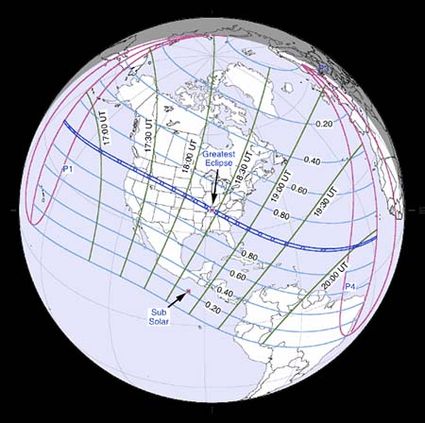Preparing for the August 2017 Total Solar Eclipse

On August 21, 2017, a total eclipse of the Sun is visible from within a narrow corridor that traverses the United States of America. The path of the Moon's umbral shadow begins in northern Pacific and crosses the USA from west to east through parts of the following states: Oregon, Idaho, Montana, Wyoming, Nebraska, Kansas, Iowa, Missouri, Illinois, Kentucky, Tennessee, North Carolina, Georgia, and South Carolina (note: only a tiny corner of Montana and Iowa are in the eclipse path). The Moon's penumbral shadow produces a partial eclipse visible from a much larger region covering most of North America.
On Monday, Aug. 21, 2017, a total eclipse will cross the entire country, coast-to-coast, for the first time since 1918. Weather permitting, the entire continent will have the opportunity to view an eclipse as the moon passes in front of the sun, casting a shadow on Earth's surface.
The total solar eclipse begins near Lincoln City, Oregon, at 10:15 a.m. PDT (1:15 p.m. EDT). Totality ends at 2:48 p.m. EDT near Charleston, South Carolina. The partial eclipse will start earlier and end later, but the total eclipse itself will take about one hour and 40 minutes to cross the country.
Solar eclipses occur when the moon blocks any part of the sun. Total solar eclipses, however, are only possible on Earth because of a cosmic quirk of geometry: The sun's diameter is 400 times wider than the moon's, but it is also 400 times farther away. The result is that the sun and the moon appear to be the same size from our perspective. When they line up just right, the moon can obscure the sun's entire surface, creating a total solar eclipse. This line-up occurs once every 12 to 18 months. Partial solar eclipses, on the other hand, occur when the alignment is such that the moon blocks only part of the sun, and these can occur more frequently.
During a total eclipse, we have the rare opportunity to look directly at the sun's vast, striking outer atmosphere, the corona. The corona appears as pearly white rays and streamers, radiating around the lunar disk. The August 2017 eclipse will present this exciting opportunity to millions across the entire country.
But total solar eclipses are more than simply beautiful to look at. They provide unique opportunities for science – and many kinds of science at that. Indeed, total eclipses throughout history have paved the way for major scientific findings across various disciplines.
"An eclipse teaches us so many things, but the 2017 eclipse is especially unique because of the uninterrupted land masses it will pass over," said Lika Guhathakurta, an astrophysicist at NASA Headquarters in Washington. "This will allow us to maximize our chance to collect data and connect the shadow of the moon to Earth science."
"There is a whole spectrum of colors of light that our eyes cannot see," University of Hawaii astronomer Shadia Habbal said. "From these different colors, we can directly probe into the physics of the corona." Different colors provide unique information about the temperature and composition of solar material in the corona.
It is in the corona that we observe giant solar eruptions like solar flares and coronal mass ejections, and the origin of the solar wind, the continuous flow of charged particles from the sun. All of these constantly shape the very nature of the space around Earth and other planets. Studying the corona and its role in the interconnected sun-space system is crucial for understanding not only the relationship between Earth and the sun, but also the space environment our satellites and astronauts must travel through for future exploration.
Of course, the beauty of the August 2017 eclipse is that anyone can view it – no science background or heavy-duty equipment is required.
But even during an eclipse, it is not safe to look directly at the sun – except for the brief phase of totality, when the moon fully obscures the sun. The only safe way to look directly at the partially eclipsed sun is through a specialized filter. Eclipse glasses are equipped with the proper filters to minimize ultraviolet, visible and infrared light.
When viewing a partial eclipse, observers must use eye protection at all times. Partial eclipses can be observed indirectly by projection, in which viewers watch the eclipse on a screen. These can be easily constructed at home with few, simple materials – such as a piece of paper and cardboard box.





Reader Comments(0)